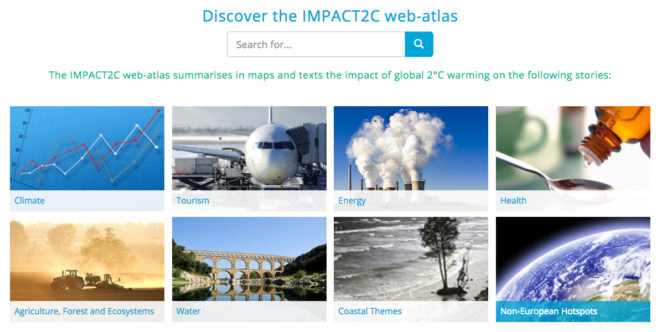The IMPACT2C web-atlas

Introduction
Based on the comprehensive research results from the EU-funded IMPACT2C project, the IMPACT2C web-atlas is an interactive, user-oriented, self-explaining and intuitive tool that allows viewers to quickly find user-tailored information about how a 2°C global warming might affect different sectors or regions throughout Europe, and for some of the most vulnerable regions of the globe.
The IMPACT2C web-atlas depicts the climate change impacts of a +2°C global warming for the key sectors – energy, water, tourism, health, agriculture, ecosystems and forestry, as well as coastal and low-lying areas, – at both the pan-European level, and for West and East Africa, Bangladesh and the Maldives. By using a multi-model ensemble of both climate and impact projections it is possible to define ranges of impacts and therefore quantify some of the uncertainty around future climate and climate impact projections.

For each of the sectors and regions, the IMPACT2C web-atlas tells visual stories of potential impacts for different topics related to a specific sector or region. The web version of the atlas allows the reader to explore the various interlinkages within a specific sector and regions as well as between sectors. By presenting a wide variety of potential climate change impacts, the IMPACT2C web-atlas aims to serve various audiences in gathering information for the development of recommendations on possible adaptation strategies on national and international levels.
Navigation within the atlas is guided by changing picture motives and smart linking, with informative maps and figures providing further information. For beginners, support on the usage and content of the web-atlas is provided by a short and easily-understandable tutorial (via a tab in the top-right corner of the homepage).
“The IMPACT2C results clearly and distinctly show that a global warming of 2°C is going to change many facets of life. This will influence not only Africa, Bangladesh nor low-lying regions and the island states, but these changes will also affect Europe, albeit weaker than the previously mentioned regions. To vividly illustrate these findings, easily accessible by the general public and to sensitize decision-makers for the challenges and opportunities of climate change, we have designed and implemented the IMPACT2C web-atlas”
Dr. Daniela Jacob, Director of GERICS and Coordinator of the IMPACT2C project.
Key Messages from the IMPACT2C web-atlas
- A global warming by 2°C substantially affects a wide range of sectors and regions throughout Europe.
- Some regions or sectors will benefit from a future warming, but some will experience disadvantages.
- To assess the impacts of climate change on specific sectors, cross-sectoral relationships have to be included in the analysis.
- In most regions of Europe, the projected regional warming is more pronounced than the global mean warming. Projections for annual mean precipitation show wetter conditions in northern Europe and drier conditions in southern Europe.
- Under a 2°C global warming, a European-wide increase in the frequency of extreme events is expected. Heatwaves are projected to double while extreme precipitation events tend to become more intense.
- A limitation to 2°C global warming will not stop sea-level rise due to the delayed reaction of the oceans. Therefore costs due to coastal flooding will incur even with adaptation measures.
- Bangladesh and the low-lying islands like Maldives are expected to feel the consequences of climate change, due to the continuous rise of sea-levels enhancing the risk for storm surges and flooding.
- For West and East Africa, the warming is above the global temperature increase. West Africa could experience a modest increase in rainfall, whereas for East Africa no clear trend is projected.
The IMPACT2C web-atlas was released and is maintained by the Climate Service Center Germany (GERICS), which is based in Hamburg, Germany.
Note: The IMPACT2C web-atlas is designed to be a living document. It will continue to grow as further topics and stories are added in the near future. Please stay tuned to see these new additions. In order to help the developers make the web-atlas more user-friendly, we invite you to send us your suggestions and ideas for further improvement of the tool. Please send them through the contact button on the upper right of the homepage.
Related resources
- Go to the IMPACT2C web-atlas
- Read about the IMPACT2C web-atlas (background, concept and dealing with uncertainty)
- Read an interview with Dr. Daniela Jacob about the Web-Atlas and the results of the IMPACT2C-project
- Read about the IMPACT2C project on weADAPT
- Visit the IMPACT2C project website
- Read about the IMPACT2C web-atlas on GERICS
- Visit GERICS, the Climate Service Center, Germany
(0) Comments
There is no content